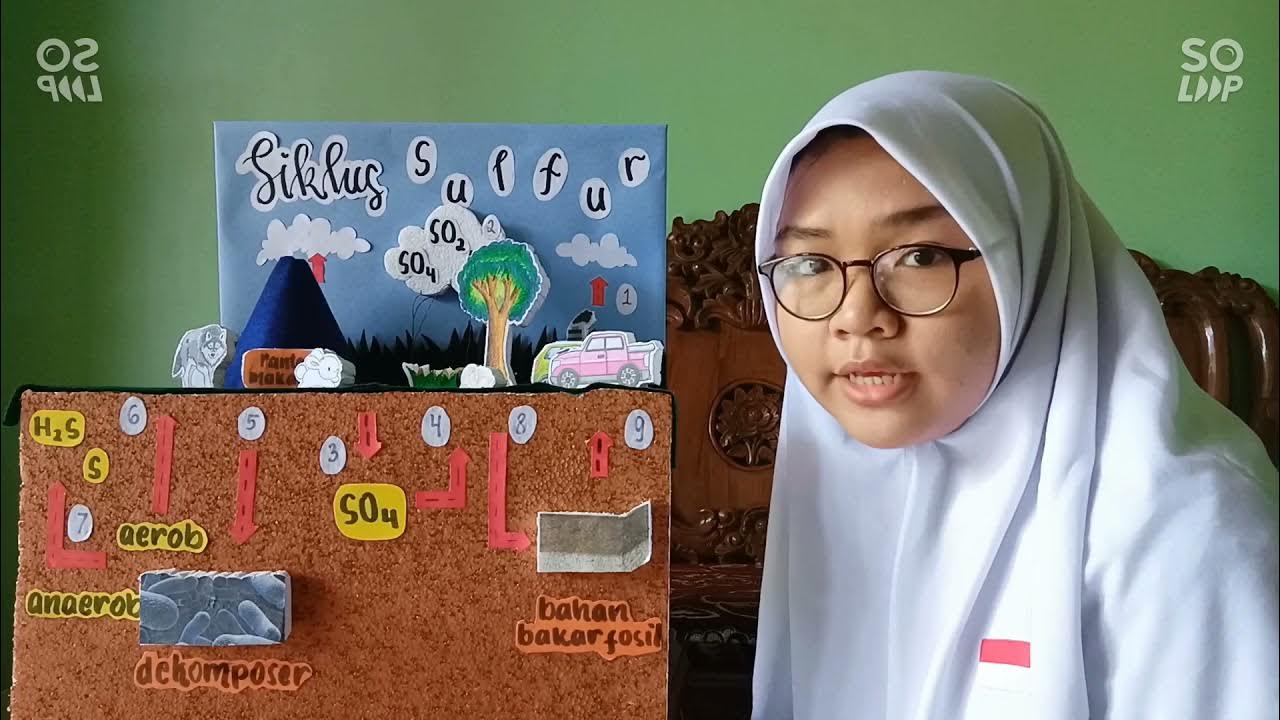Ciclos biogeoquímicos - azufre
Summary
TLDRIn this video, the sulfur biogeochemical cycle is explained in a comprehensive yet simplified manner. The cycle spans through the atmosphere, hydrosphere, and lithosphere, showing how sulfur moves between living organisms, soils, oceans, and the air. Key sources of sulfur include fertilizers, volcanic activity, decomposition, and industrial combustion. The role of sulfur-fixing bacteria and the importance of maintaining a balanced sulfur cycle are also highlighted. The video emphasizes the consequences of sulfur accumulation, such as acid rain and soil toxicity, stressing the need for the cycle to regenerate at a sustainable pace to ensure the survival of plants and animals.
Takeaways
- 😀 The sulfur biogeochemical cycle, like other cycles, involves the flow of sulfur atoms through living organisms, the atmosphere, hydrosphere, and lithosphere.
- 😀 Sulfur originates from both natural and artificial sources such as fertilizers, which are rich in sulfates and sulfur oxides.
- 😀 Fertilizers can directly affect soils, rivers, lakes, and seas, potentially causing environmental damage, though the impact depends on the quantity.
- 😀 Decomposition of organic matter naturally produces sulfur compounds, including sulfur oxides and hydrogen sulfide gas, which gives off the characteristic rotten egg smell.
- 😀 Hydrogen sulfide is a waste product of organisms, including humans, and is a natural byproduct of organic decomposition.
- 😀 Sulfur in the environment can accumulate in soils, seas, and the atmosphere, with volcanic eruptions and rock weathering also releasing sulfur compounds.
- 😀 Volcanic activity, which releases sulfur oxides and hydrogen sulfide, contributes sulfur to the atmosphere and surrounding environments.
- 😀 Sulfate-rich rocks and slate, when eroded, release sulfur oxides and hydrogen sulfide into the environment.
- 😀 Sulfovibrio bacteria play a crucial role in the sulfur cycle by converting sulfate ions into hydrogen sulfide, making sulfur available to plants.
- 😀 Industrial combustion processes can introduce sulfur into the environment, but if the amount respects the natural sulfur cycle, they don't pose a problem. The issue arises when the cycle is overloaded.
- 😀 Excessive accumulation of sulfur in the atmosphere or soil can lead to acid rain, affecting pH levels and potentially making it difficult for life to thrive.
- 😀 The sulfur cycle must regenerate at a natural pace, as sulfur that accumulates in the atmosphere or soil must eventually return to the environment to be reused by organisms.
Q & A
What is the sulfur biogeochemical cycle?
-The sulfur biogeochemical cycle describes the movement of sulfur atoms through various Earth systems, including living organisms, the atmosphere, the hydrosphere (water bodies), and the lithosphere (earth's crust).
What are the primary sources of sulfur in the cycle?
-The primary sources of sulfur include organic decomposition (from plants and animals), fertilizers, volcanic activity, erosion of sulfur-rich rocks, and industrial combustion.
How does sulfur enter the soil and water bodies?
-Sulfur enters the soil and water bodies mainly through the decomposition of organic matter, which can release sulfur in the form of sulfates and sulfur oxides, or through industrial fertilizers and pollutants that are washed into rivers and seas.
What role do bacteria play in the sulfur cycle?
-Bacteria, specifically Sulfovibrio, are crucial in the sulfur cycle because they convert sulfate ions in the soil into hydrogen sulfide gas (H2S), which can then be released into the atmosphere or returned to the soil, playing a key role in sulfur fixation for plants.
Why is hydrogen sulfide gas significant in the sulfur cycle?
-Hydrogen sulfide is a byproduct of decomposition and volcanic activity. It is a significant component in the sulfur cycle because it contributes to the sulfur content in the atmosphere, which eventually returns to the soil or water bodies in various forms.
How do volcanic eruptions contribute to the sulfur cycle?
-Volcanic eruptions release sulfur-rich gases, including sulfur dioxide and hydrogen sulfide, into the atmosphere. These gases then participate in the sulfur cycle by returning to the Earth's surface in rain or contributing to atmospheric sulfur levels.
What happens when sulfur accumulates excessively in the environment?
-Excessive sulfur accumulation can lead to environmental problems such as soil acidification, which makes it difficult for plants to grow, and acid rain, which can harm both terrestrial and aquatic ecosystems by altering their pH levels.
How does the atmosphere contribute to the sulfur cycle?
-Sulfur from natural sources, like volcanic activity or organic decay, is released into the atmosphere in the form of sulfur gases. These gases can eventually return to the soil and oceans as acid rain or precipitate as sulfates.
What is the effect of industrial sulfur combustion on the sulfur cycle?
-Industrial combustion, when it releases large amounts of sulfur into the atmosphere, can disrupt the sulfur cycle. If sulfur accumulates faster than it can be naturally processed, it leads to environmental issues like acid rain and soil contamination.
Why is it important for sulfur to return to the soil and seas after being in the atmosphere?
-Sulfur needs to return to the soil and seas because it is essential for life. Plants and other organisms depend on sulfur for growth. If sulfur remains in the atmosphere without cycling back, it cannot be utilized by living organisms, disrupting ecosystems.
Outlines

Этот раздел доступен только подписчикам платных тарифов. Пожалуйста, перейдите на платный тариф для доступа.
Перейти на платный тарифMindmap

Этот раздел доступен только подписчикам платных тарифов. Пожалуйста, перейдите на платный тариф для доступа.
Перейти на платный тарифKeywords

Этот раздел доступен только подписчикам платных тарифов. Пожалуйста, перейдите на платный тариф для доступа.
Перейти на платный тарифHighlights

Этот раздел доступен только подписчикам платных тарифов. Пожалуйста, перейдите на платный тариф для доступа.
Перейти на платный тарифTranscripts

Этот раздел доступен только подписчикам платных тарифов. Пожалуйста, перейдите на платный тариф для доступа.
Перейти на платный тарифПосмотреть больше похожих видео
5.0 / 5 (0 votes)






